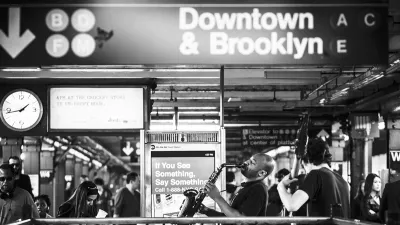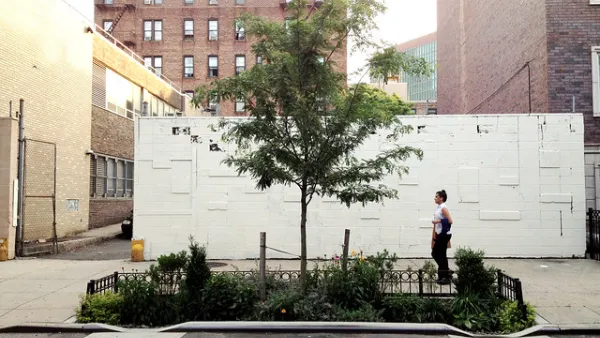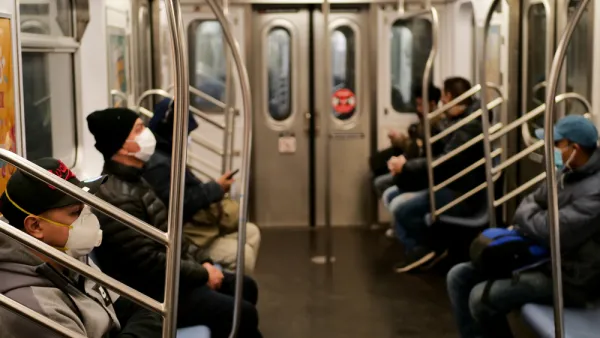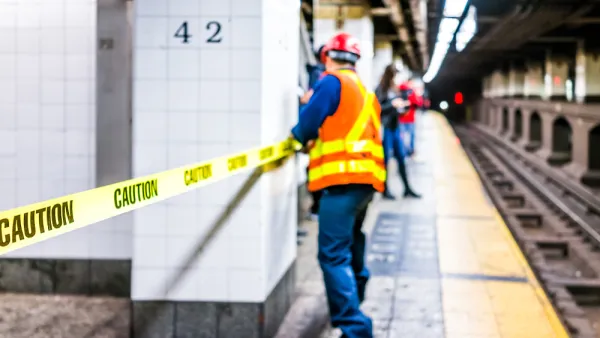While the New York subway's need for infrastructure investment is well documented, it was an improperly placed rail that caused two subway cars to derail on a southbound A train on Tuesday morning in Harlem.

The Metropolitan Transportation Authority "is now checking rails across the system to make sure replacement parts are being properly stored," report Jonathan Wolfe and Emma G. Fitzsimmons for The New York Times in one of several articles on the June 21 derailment.
The accident, which left at least 34 people injured [Planetizen put the number at 37] took place between the 135th Street and 125th Street stations. Two cars jumped the tracks after the emergency brakes were activated, officials said.
Human error was also the cause of a derailment almost two decades ago, on July 3, 1997, that occurred on the A Train line injuring 13 passengers and two firefighters.
A southbound A train jumped the track as it passed through 135th Street station at St. Nicholas Avenue. A worker who was fixing the switches at the station had accidentally flipped a switch for the wrong track.
The derailment added a new dimension to the concerns of the almost six million weekday commuters who rely on the nation's largest subway. "Until Tuesday, the main concern for riders had been long and unpredictable delays in a fraying system," report Fitzsimmons and Marc Santora in an earlier piece. "But in a flash, the concern shifted from inconvenience to questions about basic safety."
While human error was the cause of these two derailments, aging equipment in the 112-year-old system is causing delays plaguing every line. However, "it is not the No. 1 reason," report Fitzsimmons, Ford Fessenden, and K.K. Rebecca Lai in a related article.
The major cause of subway delays is a factor that basically did not exist 15 years ago: overcrowding. The subway is a victim of its own success and the city's resurgence. Large crowds slow down trains, which creates more crowding in a vicious circle that takes hours to unwind during every rush.
The article has a chart showing delays attributed to overcrowding, track maintenance, and signal failures or other track problems. The reporters chronicle the increase in subway ridership, which has reached "the highest level since the 1940s."
FULL STORY: New York Today: Derailment Answers and Your Commute

National Parks Layoffs Will Cause Communities to Lose Billions
Thousands of essential park workers were laid off this week, just before the busy spring break season.

Retro-silient?: America’s First “Eco-burb,” The Woodlands Turns 50
A master-planned community north of Houston offers lessons on green infrastructure and resilient design, but falls short of its founder’s lofty affordability and walkability goals.

Delivering for America Plan Will Downgrade Mail Service in at Least 49.5 Percent of Zip Codes
Republican and Democrat lawmakers criticize the plan for its disproportionate negative impact on rural communities.

Test News Post 1
This is a summary

Test News Headline 46
Test for the image on the front page.

Balancing Bombs and Butterflies: How the National Guard Protects a Rare Species
The National Guard at Fort Indiantown Gap uses GIS technology and land management strategies to balance military training with conservation efforts, ensuring the survival of the rare eastern regal fritillary butterfly.
Urban Design for Planners 1: Software Tools
This six-course series explores essential urban design concepts using open source software and equips planners with the tools they need to participate fully in the urban design process.
Planning for Universal Design
Learn the tools for implementing Universal Design in planning regulations.
EMC Planning Group, Inc.
Planetizen
Planetizen
Mpact (formerly Rail~Volution)
Great Falls Development Authority, Inc.
HUDs Office of Policy Development and Research
NYU Wagner Graduate School of Public Service





























